Spring Fever in Tehachapi
TEHACHAPI, Calif. — It was early spring, maybe a little too early for the Mourning Cloak Ranch and Botanical Gardens.
In late March, the time of my visit, the garden’s resplendent lilacs, madroños, heather, manzanita and crab-apple trees had not reached their April bloom. The prolific peonies of May were weeks away from flowering too.
But as I climbed the winding paths, a secret garden began to emerge: Oregon grape and brilliant clusters of yellow, white and orange daffodils. A waterfall cascading into a pool, kept company by a miniature red-leaf maple and statues of two Japanese cranes.
I turned my head and saw a trio of mule deer about 30 feet away. Or were they statues too? A doe twitched her ears, and the three departed, daintily picking their way down the hillside.
Sufficient rain can turn the high desert here into a beautiful carpet of wildflowers, but this winter was dry. So it was with trepidation that I talked my parents, Royal and Bobbe, into a search for the elusive blooms.
In the end, the flowers didn’t matter much anyway. In Tehachapi we found other pleasing diversions, places such as Mourning Cloak that turned out to be the seeds of a colorful getaway.
We started out on a Friday, driving on California 14 from Los Angeles toward Tehachapi, two hours north. Long before we reached the Antelope Valley California Poppy Reserve west of Lancaster, it was obvious that the brown hills weren’t going to yield any breathtaking displays this year.
Near the reserve headquarters, a few couples wandered around looking for poppies. Some windblown specimens were on the north slope, but the most dramatic sight was a diamondback rattlesnake curled up in a sunny spot under a picnic table.
Five miles farther west is the Arthur B. Ripley Desert Woodland, a 566-acre state park where juniper and Joshua trees flourish on land once scraped bare for farming. Desert flora loomed ahead like some alien jungle, the strange arms of the Joshua trees twisting every which way. But like the poppy reserve, this park had scant wildflowers. (For information on either park, go to
By midafternoon we reached Tehachapi and continued about 15 miles southwest of town toward the Resort at Stallion Springs. We zigzagged through flat fields of young grass, then crossed a covered wooden bridge and followed the road up the hill to the Stallion Springs lodge, center of a resort that includes a golf course, riding stables, a lake for fishing and an Old West Main Street.
The lodge sits high on a rocky precipice overlooking a valley and the cloud-capped Tehachapi Mountains. California live oaks dot the hillsides. The setting reminded me of another place I once stayed, a game lodge in Africa overlooking wild herds roaming a valley below. No herds roamed here (unless you count the local ostrich farm), and the buildings needed some paint, but the view was spectacular and the lodge was a welcoming place with a lighted fireplace in the lobby.
Standard spring and summer rates for a double range from $80 to $110 per night. Our room for three, with a senior discount about $100 plus tax, was large, comfortable and very, very quiet.
Along the highway into Tehachapi, we had seen signs advertising Domingo’s Mexican & Seafood Restaurant. We decided to give it a try. Royal was happy with his beef taco combination plate; Mother and I ordered carnitas tacos and enchiladas rancheras. The pork was overcooked, but the enchiladas were wonderful, the margaritas were tasty and we couldn’t get enough of the homemade salsa.
Saturday morning was glorious. Spiraling cumulus clouds drifted over the mountains, and the air was cold and crisp as we set off for Mourning Cloak Ranch and Botanical Gardens, an old Tehachapi ranch that Marian and Ed Sampson bought in 1973 and turned into a thriving showcase of flora and fauna.
The 30-acre property, named for a species of butterfly, is a bird sanctuary boasting 104 species. More than 2,600 cultivars, including about 500 native California plants, cover the hillsides around the main house and outbuildings. The gardens are officially open May through October, but I had found out by phone that we could take an early-season self-guided tour for $5 per person. (Reservations are required; guided tours are also available year-round. Call [661] 822-1661 or go to
Not counting the deer, we had the gardens all to ourselves. According to my brochure, the schoolhouse of the long-vanished town of Williamsburg, founded in 1869, once stood in the oak grove here. At the foot of a hill, I came across a red and white barn where three Shetland ponies shared a roomy corral.
We headed into town for lunch, serendipitously driving past the Apple Shed, a restaurant, bakery and gift shop housed in a refurbished railroad shed. We got a table by the window and watched trains pass by while Mother and I enjoyed a spinach salad with a terrific raspberry vinaigrette, and Royal feasted on homemade chili. Best of all: homemade peach pie made with local fruit.
Royal is a retired engineer from the Jet Propulsion Laboratory in Pasadena, and he was eager to see the Tehachapi railroad loop and the region’s iconic wind farms. The loop, about eight miles west of town, is still considered one of the great engineering feats of the 19th century Old West: switchbacking railroad tracks that rise slowly inside one tunnel known simply as No. 9. The project, completed in 1876, bridges the elevation difference between Central and Southern California rail lines without ever exceeding a grade of 2.2%. When the engine of a 4,000-foot-long train emerges from the top of the tunnel, it is 77 feet above its caboose at the bottom.
As if this sight wasn’t compelling enough, I peered at the tracks in the valley below and noticed purple lupine and small yellow blossoms on narrow silver stalks. Aha, I thought: wildflowers!
We drove southwest of Tehachapi to the phalanxes of tall white windmills marching across the hills. This is the Tehachapi-Mojave Wind Resource Area, where nearly 5,000 turbines harvest the gusts that blow regularly around here. The facility generates about 2 billion kilowatt-hours of electricity annually, one official said, enough to power far more than a million homes.
Weekday tours can be arranged with either Michael Burns of Oak Creek Energy Systems, (661) 822-6853,
Our last stop of the day was Chaps, Stallion Springs’ warm, wood-paneled restaurant with fine views. Dinner--excellent steak and medallions of pork--was as pleasing as the setting.
The next day, great slabs of gray clouds were sandwiched between earth and sky. Rain poured down. I made one last stab at my original mission. “Where are the wildflowers?” I asked the receptionist at the lodge.
She pointed up at the heavens. “They’re right there.”
Susan James is a freelance writer based in La Cañada.
More to Read
Sign up for The Wild
We’ll help you find the best places to hike, bike and run, as well as the perfect silent spots for meditation and yoga.
You may occasionally receive promotional content from the Los Angeles Times.






